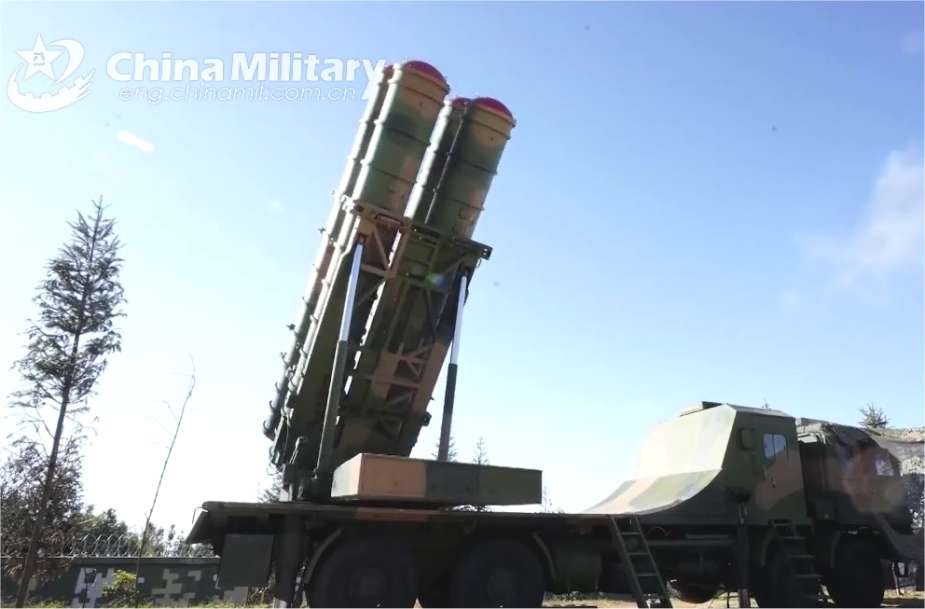Breaking news
Chinese Army Conducts Major Live-Fire Air Defense Exercise on China-Myanmar Border.
The Southern Theater Command of the Chinese People's Liberation Army (PLA Chinese Army) started a live-fire air defense exercise on the China-Myanmar border on April 17, 2024, as part of its annual training. The exercise involves both army and air force units and is designed to enhance the troops' combat readiness and operational capabilities.
Follow Army Recognition on Google News at this link

Chinese army has conducted live firing exercises on the China-Myanmar border with HQ-22 Long-Range Air Defense Missile System. (Picture source China MoD)
According to a press release from the Chinese Army Southern Theater Command, the primary objectives of the drill are to evaluate and improve the Chinese troops’ capabilities in areas such as reconnaissance and early warning, three-dimensional blockade and control, warning and expulsion, as well as air defense strikes. The exercise underscores the PLA's (Chinese People's Liberation Army) commitment to maintaining national sovereignty, border stability, and the security of its citizens.
Chinese Military Officials stated that the training is a routine military activity scheduled under the annual training plan and is not targeted at any particular country. This initiative reflects China's strategic emphasis on safeguarding its frontiers and preparing its military forces to handle various contingencies effectively.
The exercise also demonstrates the PLA's readiness to respond swiftly to any emergency, ensuring the safety of people’s lives and property along the border regions. The Southern Theater Command reaffirmed its dedication to upholding peace and stability in the area.
Since the military coup in February 2021, when the military overthrew the democratically elected government led by Aung San Suu Kyi's National League for Democracy, Myanmar has descended into a severe civil war. The military, now ruling as a junta, has escalated its violent crackdown on the population to maintain control.
In response, a national armed resistance has emerged, challenging the junta’s authority. This resistance includes several of the country’s prominent ethnic armed groups, such as the Karen National Union (KNU), which now significantly threaten the junta's hold on power. Additionally, there is growing apprehension among the resistance and the citizens of Myawaddy about the possibility of the military conducting aerial bombings, similar to tactics it has employed in other regions it no longer controls.
Since Myanmar's military coup in February 2021, the relationship between Myanmar and China has been marked by strategic alignment and mutual dependency. China has played a crucial role in providing diplomatic support to Myanmar's military junta, protecting it from international criticism and potential sanctions. This support is critical for Myanmar as it faces widespread condemnation for its actions during and after the coup. Moreover, China views Myanmar as an integral part of its broader regional ambitions, particularly through initiatives like the Belt and Road Initiative, where Myanmar's strategic location is pivotal.
In terms of military ties, China has a long history of being a major arms supplier to Myanmar, and this relationship has likely persisted post-coup, although specific details on the continuance and extent of such support are not widely disclosed. These military connections are part of a broader pattern of engagement that includes significant economic and infrastructural investments, encompassing projects that have strategic implications beyond their economic value. This multifaceted support underscores China's broader strategy of ensuring stability and expanding its influence in Southeast Asia through a combination of diplomatic, economic, and military efforts.
There are reports that China has supplied drones to the Myanmar military, which have been used to monitor protests and enhance military operations against resistance movements. These actions underscore China's pragmatic approach towards Myanmar, contrasting with Western sanctions and calls for a return to civilian rule.
According to the SIPRI (Stockholm International Peace Research Institute) Arms Trade Database, since 2010, China has delivered a large quantity of military equipment and weapons to Myanmar, including anti-ship missiles (C-802), armed UAVs (CH-3), anti-aircraft guns (GDF-35), fighter aircraft (JF-17), KS-1A air defense missile systems, and transport aircraft (Y-12 and Y-8).
China has maintained a supportive stance towards Myanmar's military government following the February 2021 coup. Recent reports indicate that China has provided substantial aid and support, including military and diplomatic backing, to the Myanmar junta. This aid is part of a broader strategy to maintain stability in Myanmar, which is crucial for China's strategic and economic interests in the region, particularly the China-Myanmar Economic Corridor.
Defense News April 2024


























